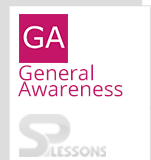 Introduction
Introduction
General Awareness is an important component of most of the competitive exams for employment in the government sector in India. The article IBPS SO Prelims General Awareness Quiz 3 presents questions related to IBPS PO, SSC CGL, SSC MTS, SSC CHSL, SEBI Grade A, Indian Bank PGDBF PO, LIC HFL, NIACL Assistant, RRB Assistant, RRB PO, SBI Clerk, SBI PO, RBI Grade B and BOB PGDBF PO. The article IBPS SO Prelims General Awareness Quiz 3 have been designed keeping in view the significant role of General Awareness sections in the scoring of competitive exams. IBPS SO Prelims General Awareness Quiz 3 is very useful to crack the General Awareness sections of several competitive exams.
 Quiz
Quiz
1. If a person does not have any of the proofs for completing KYC, then he can get his bank account open as a ______.
- A. Small account
B. BSBDA account
C. Recurring deposit account
D. Nostro account
E. Vostro account
- A. During high levels of inflation, the RBI decreases the reverse repo
B. Reverse repo rate is lower than the repo rate
C. It is used as a measure to manage cash flow
D. It involves the transfer of money from one account to another
E. It is the rate at which the RBI borrows from the commercial banks
- A. City Code
B. Bank Code
C. Branch Code
D. Account holder code
E. Country Code
- A. 100
B. 200
C. 300
D. 400
E. 500
- A. Balance of trade
B. Balance of revenue
C. Balance of access
D. Balance of funds
E. None of the above
1. Ancient holy city in Maharashtra, Nashik is situated on the banks of river _________.
- A. Yamuna
B. Godavari
C. Ganga
D. Chambal
E. Mahanadi
- A. Maharashtra
B. Madya Pradesh
C. Rajasthan
D. Gujarat
E. West Bengal
- A. Blackbuck National Park
B. Campbell Bay National Park
C. Dudhwa National Park
D. Eravikulam National Park
E. Gangotri National Park
- A. Peso
B. Kuna
C. Koruna
D. Rial
E. Somoni
- A. August, 10
B. September, 30
C. September, 18
D. September, 15
E. August, 29
1. Which is the only country to which remittances can be sent using NEFT?
- A. Nepal
B. Canada
C. United States
D. Sri Lanka
E. Mauritius
- A. Bankers’ Cheques are issued by a bank to the individual.
B. The fund is withdrawn directly from the account of the bank.
C. The fund is payable within the same city in which it has been issued.
D. All (A), (B), (C)
E. Only (A) and (B)
- A. Payment and Settlement Systems (PSS) Act 2007.
B. Foreign Exchange Management Act, 1999
C. Banking Regulation Act, 1949
D. SARFAESI Act, 2002
E. None of the Above
- A. ICICI Bank
B. SBI
C. Central Bank of India
D. Bank of Baroda
E. None of these
- A. Treasury Bill Market
B. Basel norms
C. Foreign Exchange Market
D. Inter-Bank Call Money Market
E. None of these



